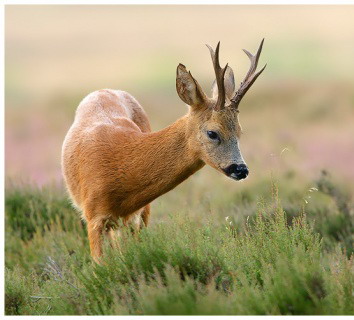
Roe deer(Capreolus capreolus)
Phylum —chord
Class — mammalia
Order — artiodactyla
Family — сervidae
Genus – сapreolus
Appearance
The roe deer is a relatively small deer, with a body length of 95–135 cm (3.1–4.4 ft), a shoulder height of 65–75 cm (2.1–2.5 ft), and a weight of 15–35 kg (33–77 lb). In good conditions develop antlers up to 20–25 cm (8–10 in) long with two or three, rarely even four, points.
Habitat
The species is widespread in Europe, from the Mediterranean to Scandinavia, from Scotland to the Caucasus, and east to northern Iran and Iraq.
Behavior
In order to mitigate risk while foraging, roe deer remain within refuge habitats (such as forests) during the day. They are likelier to venture into more open habitats at night and during crepuscular periods when there is less ambient activity. Similarly, roe deer are more likely to be spotted in places with nearby forests to retreat to if there is a perceived threat.
When alarmed, it will bark a sound much like a dog and flash out its white rump patch. Males may also bark or make a low grunting noise. Females make a high-pitched "pheep" whine to attract males during the rut (breeding season) in July and August. The roe deer is territorial, and while the territories of a male and a female might overlap, other roe deer of the same sex are excluded unless they are the doe's offspring of that year.
Diet
They feed mainly on grass, leaves, berries, and young shoots. They particularly like very young, tender grass with a high moisture content.
Reproduction
The polygamous roe deer males clash over territory in early summer and mate in early autumn. During courtship, when the males chase the females, they often flatten the underbrush, leaving behind areas of the forest in the shape of a figure eight called 'roe rings'. Males may also use their antlers to shovel around fallen foliage and soil as a way of attracting a mate. Roebucks enter rutting inappetence during the July and August breeding season.
Females are monoestrous and after delayed implantation usually give birth the following June, after a 10-month gestation period, typically to two spotted fawns of opposite sexes. The fawns remain hidden in long grass from predators; they are suckled by their mother several times a day for around three months.
Young female roe deer can begin to reproduce when they are around 6 months old. During the mating season, a male roe deer may mount the same doe several times over a duration of several hours.
In captivity
The roe deer attains a maximum lifespan (in the wild) of 10 years.
Keeping and breeding ofa roe deer in the backyard will not be difficult, as small deer easily adapt to the cultivated landscape, to the life next to a human. Doing this, a fence made of galvanized mesh 1.5-2 m high is constructed on the plot of land. Water drinkers and feeders are installed inside the enclosure. The enclosure can contain a large number of animals - up to 5-7 individuals per 2.5 acres.
Roe deer prefer easily digested plant food rich in water and nutrients. They eat young shoots,leaves of plants, the bark of trees, cereals, berries and juicy fruits, beech nuts, chestnuts, acorns, mushrooms and lichenswith great pleasure.
Daily amount of food for roe deerthe following: oatmeal –in winter - 450 g, in spring - 700 g, in summer - 500 g, in autumn - 750 g; branch feed or hay - 1-2 kg in all seasons of the year. In the hottest summer timeRoe deer need 1-2 liters of water per day.
Often artificial salt pans are arranged inside aviaries and calcium is added to the diet in the form of powdered chalk.
 Russian
Russian
 English
English























